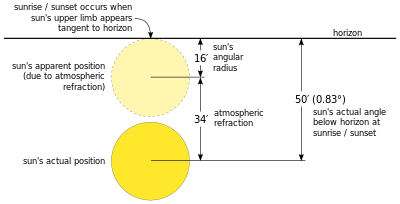Natural Phenomena

Hazy summer sunrise over the Mojave Desert
Sunrise (or Sun up) is the moment when the upper limb of the Sun appears on the horizon in the morning. The term can also refer to the entire process of the solar disk crossing the horizon and its accompanying atmospheric effects.
Terminology
"Rise"

 Although the Sun appears to "rise" from the horizon, it is actually the Earth's motion that causes the Sun to appear. The illusion of a moving Sun results from Earth observers being in a rotating reference frame; this apparent motion is so convincing that most cultures had mythologies and religions built around the geocentric model, which prevailed until astronomer Nicolaus Copernicus first formulated the heliocentric model in the 16th century.
Although the Sun appears to "rise" from the horizon, it is actually the Earth's motion that causes the Sun to appear. The illusion of a moving Sun results from Earth observers being in a rotating reference frame; this apparent motion is so convincing that most cultures had mythologies and religions built around the geocentric model, which prevailed until astronomer Nicolaus Copernicus first formulated the heliocentric model in the 16th century.
Beginning and end
Astronomically, sunrise occurs for only an instant: the moment at which the upper limb of the Sun appears tangent to the horizon. However, the term sunrise commonly refers to periods of time both before and after this point:
- Twilight, the period in the morning during which the sky is brightening, but the Sun is not yet visible. The beginning of morning twilight is called astronomical dawn.
Measurement
Angle
 Sunrise actually occurs before the Sun truly reaches the horizon because Earth's atmosphere refracts the Sun's image. At the horizon, the average amount of refraction is 34 arcminutes, though this amount varies based on atmospheric conditions.
Sunrise actually occurs before the Sun truly reaches the horizon because Earth's atmosphere refracts the Sun's image. At the horizon, the average amount of refraction is 34 arcminutes, though this amount varies based on atmospheric conditions.
Also, unlike most other solar measurements, sunrise occurs when the Sun's upper limb, rather than its center, appears to cross the horizon. The apparent radius of the Sun at the horizon is 16 arcminutes.
These two angles combine to define sunrise to occur when the Sun's center is 50 arcminutes below the horizon,
Time of day
The timing of sunrise varies throughout the year and is also affected by the viewer's longitude and latitude, altitude, and time zone. These changes are driven by the axial tilt of Earth, daily rotation of the Earth, the planet's movement in its annual elliptical orbit around the Sun, and the Earth and Moon's paired revolutions around each other. The analemma can be used to make approximate predictions of the time of sunrise.
Appearance
Colors
The colors of the sunset result from a phenomenon called scattering, says Steven Ackerman, professor of meteorology at UW-Madison. Molecules and small particles in the atmosphere change the direction of light rays, causing them to scatter.
Scattering also explains the colors of the sunrise and sunset, Ackerman says.
“Because the sun is low on the horizon, sunlight passes through more air at sunset and sunrise than during the day, when the sun is higher in the sky. More atmosphere means more molecules to scatter the violet and blue light away from your eyes. If the path is long enough, all of the blue and violet light scatters out of your line of sight. The other colors continue on their way to your eyes. This is why sunsets are often yellow, orange, and red.”

Komentar
Posting Komentar